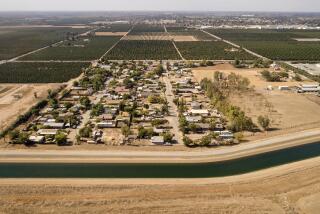Demand Water Heaters Not a Choice for All
- Share via
Our earlier column on European water heating generated several questions from readers about on-demand water heating.
Some readers are running out of hot water when they take a shower or when filling a large tub. Another reader is remodeling the bathroom and wants to get rid of the water tank for space reasons. Their questions: Would an on-demand water heater solve the problem? If so, are they compatible with any fixture? Are they reliable? Where can they be purchased?
Let’s look at the problems first. If you’re running out of hot water, this could be due to a number of factors--an element burned out (if electric), poorly insulated tank and pipes, high volume shower heads and water fixtures, and long showers.
Before making an investment in a new water heating system, try to correct these problems first. They’ll not only save you the cost of buying a new system, but reduce your utility bill each month.
If you’re still short on hot water or want to replace the water heater for space reasons, then an on-demand water heater might be a good choice. On-demand heaters are small units that heat water instantly as it passes through a heat exchanger on its way to the tap.
A small unit can be mounted under the sink or on the wall next to the shower as a supplement to your conventional water heater. It will boost the temperature of the water going to the shower, allowing you to draw less from your conventional water tank. So the likelihood of running out of water when showering is reduced.
Advantages to demand water heaters: If you’ve ever taken a hot shower when camping and had to plug the shower with quarters, chances are you were using an on-demand water heater. Widely used in remote areas and European countries where power and space is at premium, they are very reliable. They also outlive conventional water heaters by many years. That’s because tankless water heaters don’t store hot water inside the unit, so scaling and corrosion aren’t a problem. They also cost 10% to 25% less to operate.
Drawbacks to demand water heaters: As with any piece of equipment, there are drawbacks. On-demand water heaters are somewhat more costly to purchase than hot-water tanks. Even a small on-demand heater designed to supplement the conventional water heater will cost at least $150 to $200. Replacing the water heater with an on-demand heater for the whole house may run $600 to $700. Also, not all are compatible with the single faucet mixer valves found in many homes. This may require new fixtures.
If you’re still convinced it’s a good idea, other considerations include sizing, flow rates, installation and power (electric or gas). On-demand water heaters are not widely available in water heater outlets.
Every on-demand heater should be labeled with information about heating capacity. This is usually given in gallons of water per minute they can provide at a given temperature rise.
If you’re looking to boost the temperature of the water from your hot water heater, then a temperature rise of 30 to 40 degrees at 1 to 1.5 gallons per minute should be adequate. Larger units replacing the water heater and serving the whole house would probably need at least a 60 to 70 degree temperature rise at a high flow rate of 2 to 3 gallons per minute.
Newer Plys Aim at Not Shocking You
Q: I bought a new television which has one blade wider than the other on the plug. Why is one blade wider?
A: The reason you find newer electrical cords with one blade wider than the other is because of polarity. Polarity means that there is a “hot” or energized side (the thin blade) and a “return” or neutral side (the wide blade) to the wiring. When the appliance is plugged in, electricity flows in through the energized side and returns through the neutral side of the wire.
Newer plugs have a third prong (round and centered in the plug) that acts to ground the appliance. In older, two-prong plugs, grounding is done through the neutral side of the plug. If the appliance isn’t grounded correctly, the appliance body could conduct current. In that instance, when you touch the appliance, you become the ground and receive a shock.
The neutral side of the plug has an enlarged blade to aid in correctly completing the circuit. Polarized plugs have been around for a number of years, but more manufacturers are using them now to minimize the chance of customers being shocked. We are aware of no adapters that will accomplish correct grounding easier than the enlarged plug blade.
QUESTIONS TO ASK ABOUT WATER HEATERS * What are the installation requirements (electric or gas models)?
* What are the power requirements for electric units?
* What skills are required for installation?
* Can they recommend someone to install it (plumber, electrician)?
* Are they compatible with any water fixture?
* Are low-volume water fixtures recommended?
* What are the flow rate and water pressure requirements for successful operation?
Is there a product warranty?
* Has the product been safety tested by a nationally recognized laboratory (i.e., Underwriters’ Laboratories)?
* What are the maintenance requirements?


